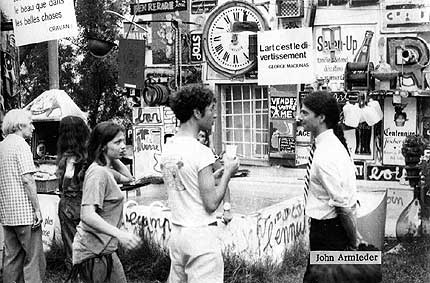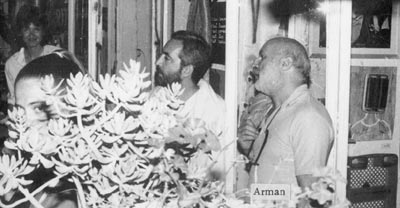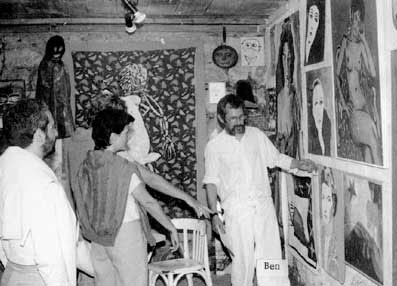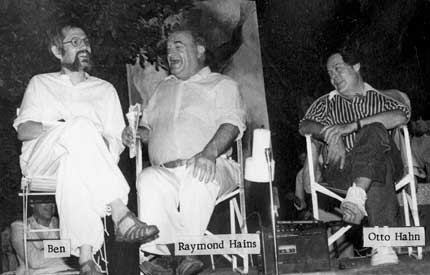Nice, 10 July – Ben Vautier
We phoned Ben from Julien Blaine’s and arranged to meet in Antibes the next day on July 9th.
As we traveled further south it got warmer and warmer, and when we reached the Cote d’Azur it was scorching hot. We camped a few kilometres from Antibes. In the afternoon we sauntered around and there was a real holiday atmosphere, then in the evening at 9 we went to the Picasso Museum, where we had to meet Ben at the opening of the Martial Raysse exhibition. The exhibition drew the crowds and we ran into some of our acquaintances: Liliane Vincy, in whose gallery we met Michel Giroud – who as it subsequently turned out had been following us for days – on the last day of our stay in Paris, cheerfully acknowledged that we were also present at this obligatory evening’s parade of the French elite, and then introduced us to Pierre Restany. When Restany found out that we were heading on to Italy, he asked us to definitely give him a ring when we reached Milan because he wanted very much like to have a little chat with us.
We were held up in the big crowd for a while before we found Ben, who had grown an enormous drooping moustache and caused us quite a surprise since we only knew him from photographs.
After the opening we went to an atmospheric café-pizzeria and chatted about all sorts of things.
Here are some excerpts:
Ben: I saw Martial’s exhibition in the Beaubourg, but I didn’t like it. I understand what he wanted to say, but, I'm not sure I agree with him… He didn’t present himself at this exhibition as a painter but rather as some kind of wise man. He had a philosophical message for us. His paintings imply that we should abandon art and instead take notice of the world and the little wonders of nature… Martial had just got over a deep depression. When he did his neons he was very successful, but he later realized that he was not strong enough to take up the fight with the likes of Warhol and Arman. They were very tough, but Martial was soft and sensitive… I recall that he was always crying, and when he came into my shop he was always in despair because of some trifle, while of course at the same time has a high opinion about himself.
Gy.G.: Now that Dick Higgins was in Berlin and he would’ve been happy to come to Budapest for a concert it looked like it might have been possible to organize a Fluxus show… but I heard you asked a fortune for it.
Ben: I asked for a lot of money? No, no it wasn’t me, it was Gino di Maggio. But you know, you should’ve made it clear when you wrote that you wanted a small exhibition…because if you say you would like “the” Fluxus Exhibition, that’s really big, just what needs transporting is 500 kilos, and the insurance costs 20,000 FF. But if this is a lot, we have a small box that we could send over – but we need it back –, this is documentary material… or what you should do is put on a live show, but it needs people, Dick Higgins and I are not enough. You also need George Brecht, Nam June Paik and Eric Andersen, in other words quite a few people. And since it’s too difficult to get together so many people, we need photos about the events that have taken place. And you know, the photos are nicely mounted on cardboard… that’s why there’s a lot of weight. If you all come tomorrow, I’ll show you the Fluxus exhibition. It’s at my place in a box – half of the material is at Gino’s and the other half’s at my place. Of course a real, large-scale Fluxus exhibition must be made up of more parts. The documentary part is simple and relatively permanent: photos from the various periods, the newspapers that we made, and we can add any new documents to the rest. Apart from this we need a concert, a live Fluxus performance and the works. Of course this all needs money. If you have millions, everybody will come, even Cage. Everybody can be bought…
On the way down to the Picasso Museum everybody dropped into little cafés. A few people came over to ask Ben what they should take to the party the following day.
Ben: Don’t bring anything special, just a little snack in case you get hungry, as I’ll be bringing some food, a bit of sausage and that kind of thing, but if hundreds of people are there, I won’t be able to feed everybody. Don’t come after dinner. We have to eat in the garden. We’ll sit down in the grass and wait for Otto Hahn to put on a show, sing, or recite something… since tomorrow evening he’ll be the entertainer. He’s coming here from Paris just because of me.
We spent the next day in Nice and in the afternoon we visited the Matisse Museum, which is a bit outside the city as well but luckily in the same direction as where Ben lives. He asked us to go there around 5 o’clock so that we would have an hour before the beginning of the party to chat.

Ben’s one-storey house is just like his booth in the Beaubourg, plastered with art inside and out. All sorts of captions and objects are hung outside, and inside he has a wonderful international collection and on the ground floor, half in the basement, there’s a painstakingly organized archive and library, and further towards the back in a makeshift storeroom are unopened boxes: the Fluxus Exhibition.
They reorganized the garden and the two garages for the evening. Since the theme of the “face à face”, i.e. face-to-face debate, was the introdoction and discussion of three trends: new realism, attitude art and free figuration, Ben organized three exhibitions for the occasion in the garden and in the garages. Arman represented new realism with a big heap of all kinds of thrown-away odds and ends: there were oxygen cylinders, an old record player, books, spools of film, items of clothing, etc. Anybody could take anything but they had to replace what they took with the same kind of thing. How the pile changed was documented every five to ten minutes with a Polaroid camera. The attitude art was represented by Filliou’s giant photowork and by Paik’s video project, which people could watch hung down over their heads in the garden. Ben had already made it clear the day before that he wasn’t going to give away anything for free and that he would only sell or exchange his works. We were relieved because we had loads to swap. So when we arrived and he took us around his house he immediately proposed that we had a look at what we could swap. He was very interested in Gyuri’s heads album and his "stamp + rubber stamp" assembling and swapped them for a couple of his impressive publications.
Time just sped by as we were looking at the works and talking about them, and by ones and twos people began to arrive. John Armleder phoned to say that he had arrived at the railway station and so around half part seven Ben went with his little minibus into the city for him and a few other people who hadn’t been able to get a lift for themselves.
The discussion started at half past eight and by that time the atmosphere was charged. The event was a blend of an elegant reception, a house party and a very good artistic debate.
A few details
Ben: So let’s get started with the debate which will be conducted by Otto Hahn about new realism, attitude art and free figuration, so you can all find out what you should buy and what you shouldn’t.
We spent two very eventful weeks here in Nice, and some people liked it and some people didn’t, but we should be grateful that there are pros and cons because that fuels debate. So let’s look at whether these exhibitions are good or not. For example, I’ve been told that Christo’s exhibition only displayed small-scale concepts that didn't amount to much, and that Arman’s exhibition comprised of nothing else but things for sale.
Otto Hahn: For a start, most of Christo’s works are concepts and the documents and everything else on the correspondence and conflicts with the various authorities in connection with the concepts and their implementation are part of the work of art itself. As far as Arman is concerned, I have seen his latest works and I was pleasantly surprised because none of these are suitable to be sold and it has been a long time since Arman made such pieces.
On the other hand, I saw the Tinguely exhibition in Zurich and Tinguely once said to me that: “we new realists – by the way, like all the other new realists, he always protested against the new realist label – did one or two things that caused a stir and maybe we’ll change, but there was a time when we were the dreaded daredevils, when we were banned from museums because we did unacceptable things.”
Ben: Well, everybody knows that…
---
Ben: In any case I 'd like to return to the three trends I’m presenting here… because everybody can see, whether at the Documenta or in Venice, or anywhere else that we are witness to a frantic resurgence of figuration, and I find this exciting because there is something very relevant in it. And I think the French participation is very important… I’m not misjudging things at all. I can clearly see what will last and what’s really good. Arman will last the course, and so will Viallat and Combas. Them three will surely stand their course.
Hahn: As far as the the new realists are concerned, they all built their own castle in a closed little group, whether we are talking about Tinguely, Arman or Hains, who after making torn posters put them in a social and historical perspective creating a new kind of interest, and this wasn’t so repetitive…
Ben (interjects): I would like to familiarize everyone with one or two opinions. For example: “new realism is like Beaujolais (a famous French wine), it doesn’t improve with age”. This was Angel’s observation and she also said we are all fools for being fed nonsense. You said that, didn't you Angel? Come here and defend yourself!
Dominique Angel: I can only add one thing to this: the manifesto you quoted my opinion from is basically about how important it is for artists to be able to free themselves from those myths and beliefs that they have been locked up in…
Ben: Good, you say this but somebody had the opposite opinion: “Ben, this is fantastic. Can you believe that in twenty years it will still be so good and so corrosive!? Even today nobody can come up with anything that would have such a corrosive effect. Take a look at Arman’s chair and César’s blue lorry. They still have an advantage over everybody else!” Lepage said this. So one person says this is idiotic nonsense, and another that it’s avantgard, so it would be nice to know what this really is. So, Lepage, what is your opinion after all? Come on and tell us! I think the exhibition in La Marine is bad.
Jacques Lepage: well, even worse…
Ben: Spoerri’s work was fantastic but at the beginning I had no idea what he wanted to say with it…
Interjection: That’s an aestheticising piece.
Lepage: Yes, and I was very surprised because the first works of new realism were ugly…p>
Ben: …and they weren’t laid on the table so tastefully.
Lepage: …but these, like Arman’s piano, later became aestheticising pieces.
Ben: Ok, I’ll tell you all what Spoerri said when standing in front of Arman’s bronze piano: “you see, when Arman smashed up the piano he wanted to shock the petit bourgeoisie. Casting a piano in bronze dissolves this shock. The petit bourgeois can recover from the initial shock with the help of bronze.” And Pierre, what do you think about this exhibition?
Pierre Naon: I think this exhibition allowed us to have a fresh look at the most important artists of the last twenty years.
Ben: Is it true that you said that new realism is the only thing that counts and that you’ve thrown yourself into it?
Naon: Whatever the case, it’s at least ten years since I’ve seen an exhibition that could be compared to this one, with such high caliber artists that we have seen here…
Hains: I agree with you there, and anyway, an artist can go through a bad period, every artist has had their bad patches. For example, Arp started off really well and then when things weren’t going so well everybody started to say: look, Arp is shit; he did dada and he’s doing this now… an artist should be judged on the sum of their work, and I’m completely opposed to the capitalist approach in which an artist is exploited between the ages of 25 and 40 and after that they say: what you're doing is shit so you can piss off…
Ben: Well, at age 40 Arp was a classic. I just said to Arman a while ago: I’m bored of you still doing the same old rubbish. He replied “what do I care, I’m already a classic. I'm untouchable.” I asked him in what way they couldn’t touch him and he answered: “I can’t fail, I’m too well established”. So, anyway, I say that 80% of those who are against free configuration think that way because they’re jealous. You’re all jealous because it’s art that sells. And I have to point out that Arman also bought art from Combas not long ago, and he doesn’t make mistakes. We can tell that there’s something behind this. Arman, you say something.

Arman: Maybe it’s a bit naïve to think that everything always has to be made into something new. We always return to the old places, and yes of course we add a little extra to them. This is the spiral of culture. What these young artists are doing really is thought-provoking and makes us re-evaluate a lot of things, even Bernard Buffet or Van Gogh, since in 1945 Bernard Buffet was not completely uninteresting.
An interjection: They want to palm Bernard Buffet, Helion and Guttuso nicely wrapped into one package on us under the label new figuration, and by doing this they want to make a big profit. Because Guttuso was always swimming in money… he was a communist when he had to be one, and a Christian democrat when it was necessary. So he was always well-off.
Arman: Otto, there’s a good saying applicable to the art trade. Lincoln said it originally but it’s true for the art trade too: “You can cheat some of the people for some of the time, some of the people all the time, but you cannot cheat all the people all the time”. An artistic trend can become popular and dominant and for a time it can suppress every other artistic expression, and maybe even define everything for a year, or maybe influence a hundred people, but it can’t suppress everything all the time.
Ben: It’s Sacha Sosno’s turn to say something. He’s the one who speaks so beautifully on the radio.
Sosno: It’s very strange that this evening, when we are talking about the new realists, nobody has even mentioned Yves Klein.
Ben: If we have a look at his main work, that wonderful blue, it’s pure abstraction.
Hains: If we consider what Restany wrote in his manifesto, i.e. that the starting point for new realism is the object, it’s obvious that Yves Klein wasn’t a new realist, unless we regard the sky as an object.
An interjection: When the new realists, held together by Restany, sat down together to write a manifesto they were incapable of agreeing about anything, and in the end the key sentence that everybody was willing to accept as a definition was: “Nouvelles approches perceptibles du réel” (the new, perceptible approaches to reality), which is typical of the empty phrases Restany would come out with.
Ben: Let me just butt in for a moment: For me Yves’ sculpture of Arman or his other plastercasts are completely meaningless. On the other hand, his monochrome is a real innovation. There are important and less important works, for example Duchamp’s Bottle Dryer (Bottle Rack) is important, but his Puns aren’t and nor is The Large Glass. Marcel Duchamp’s Large Glass is of no relevance. Maybe it’s important in some other interpretation of art history, but if we take a look at the linear development of art history, the Bottle Dryer forms the starting point of pop-art and new realism. The Large Glass was not a starting point for anything.
Hains: You always present your own peculiar interpretation, just as you like it.
Ben: Yes, but what I say is reality and true history…The story of new realism is very simple: there was the École de Paris and they ruled over the rue de Seine. Something new and different had to be done. And then Yves painted his monochrome – which was virtually his most important gesture – and with this he managed to overthrow the rule of the École de Paris with this, and the new realists and objects. So it was a real fight back then…
Arman: This is all about separate individuals who formed groups that didn’t really exist because the participants all joined them with different ideas. For example, there were some who were interested in visual representation, such as the affichistes and others who made global gestures like Yves, Christo and Manzoni, then there were others that worked with junk and worthless objects, such as Spoerri, Tinguely and I… and these were completely separate groups.
Ben: But all three trends had something in common: the starting point for all of them was Kandinsky’s abstract painting and they accepted the Bottle Dryer as their emblem. Because the posters were the Bottle Dryer, the junk was the Bottle Dryer and the global art was also the Bottle Dryer. The Bottle Dryer was behind everything.
Interjection: …and the whole thing lasted twenty minutes.
Ben: What do you mean twenty minutes?! It lasted twenty years and it’s still going on.
Arman: Maybe Martial is right when he says that art is actually anything but in a defined way.
Ben: No. Anything is Duchamp’s word, because a bottle dryer is an anything… Ok, it would be better if we had something to eat and drink now.

